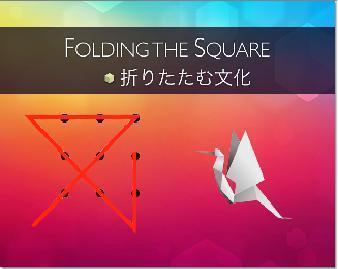Work in Japan Advice Board


- Jobs in Japan @ Daijob.com
- Folding the Square
Creative Career Path
Folding the Square2012.07.02
Interest in creativity in the West has largely focused on what has come to be called thinking out of the  box. Methods from Brainstorming to Mind Mapping to the Idea Marathon all focus on generating lots of new ideas, now matter how crazy, in order to free yourself of biased perception and open your mind to new possibilities.
box. Methods from Brainstorming to Mind Mapping to the Idea Marathon all focus on generating lots of new ideas, now matter how crazy, in order to free yourself of biased perception and open your mind to new possibilities.
The Torrance Tests of Creative Thinking (TTCT) were developed by Ellis Paul Torrance in the 1960s, and measured divergent thinking on scales of Fluency, Flexibility, Originality, and Elaboration in problem solving skills. These tests were revolutionary, in that they provided an alternative measure of intelligence to the IQ Test, and recognized that problem solving often depends more on flexible focus than on verbal and mathematical skills. Moreover, the same tests of Creativity can be used on people of all ages from kindergarten to adult. http://budurl.com/q2r2
The phrase thinking out of the box originated with the nine dots problem. The problem of how to connect the nine dots with only four lines, without taking pen from the paper, can only be solved as shown here by going out of the square. The dots only appear to create a box, and if you see it that way, you cannot solve the problem. The nine dots problem is commonly used to illustrate the process of lateral thinking, or thinking outside the box, and is a common approach to creativity. It involves changing your perspective and freeing yourself from self-imposed or apparent limitations. The problem is, once you know the solution to the problem, it seems quite obvious. The value is in discovering the solution for yourself, not in hearing it from someone else.
By contrast, the Japanese art of paper folding, know as Origami, is the art of folding the square into an astonishing variety of distinct shapes, animals, geometric figures, and objects of all sorts. All done by folding and refolding a single square sheet of paper, without any scissor cuts. It is far more challenging than the nine dot problem, because it involves manual dexterity as well as visualization. On the other hand, although someone creates the original origami shapes, for the most part people practice the art by following instructions. What is remarkable is the degree of flexible focus that was needed to come up with idea of folding paper in this way in the first place.
The art of folding is deeply ingrained in Japanese culture, and is an essential aspect of the Japanese sense of creativity and aesthetics. Japanese have refined the art of folding not only paper and clothing, but furniture, bicycles, eyeglasses, even joints of the human body in the martial arts. The Japanese ability to design products and processes that fit neatly into tight spaces is a practical necessity where space is a premium. Just as Jazz is a natural part of the American love of improvisation, the art of folding is a natural part of the Japanese love of physical finesse.
Why is folding the square significant for creativity? Not only does it result in a host of useful and practical solutions to problems and products, but it also illustrates how many possibilities open up when we work within a certain set of limitations. The discipline of working within a set of rules and restrictions can sometimes set you free to discover new levels of flexibility and finesse.
This is not always the case, or every person working in a cubicle would be flexible and creative. More often than not, restrictions can bind and tether your imagination, particularly when imposed from the outside. It is when you seek to work out solutions inside the square of your own initiative through self-discipline, that is when creativity truly comes into play.
William Reed WEBSITE: http://www.williamreed.jp WEB TV: http://williamreed.tv NANBA: http://www.nanbanote.com iPAD CREATORS CLUB: http://ipadcreatorsclub.com BLOG: http://www.EntrepreneursCreativeEdge.com
Article Writer
William Reed is a renowned author-speaker who coaches physical finesse and flexible focus for a creative career path. A certified Master Trainer in Guerrilla Marketing and 7th-dan in Aikido, he combines practical wisdom of East and West to help you learn personal branding at the Entrepreneurs Creative Edge.
Similar Articles
- 2015.08.04A Comparison between Western and Asian D...
- 2015.07.28Being an Effective Communicator
- 2015.07.21Making Your Presentation Interactive




